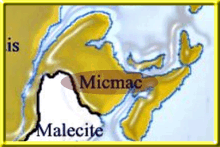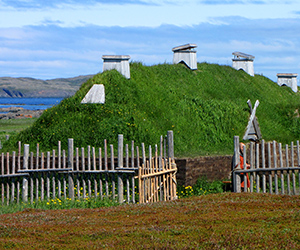CANADA HISTORY
Tlingit

The Tlingit people are indigenous to the Pacific Northwest region of North America, including what is now Alaska and parts of British Columbia. Before contact with Europeans, the Tlingit lived as a complex society with a rich cultural heritage.
The Tlingit were organized into matrilineal clans, with each clan having its own territory, traditions, and cultural identity. They relied on fishing, hunting, and gathering for their subsistence, and their economy was based on a system of barter and trade. They had a complex social structure, with a hereditary aristocracy and a warrior class.
Religion played a central role in Tlingit life, and their beliefs included a pantheon of spirits, ancestor worship, and the importance of rituals and ceremonies. The Tlingit also had a rich oral tradition, which included stories, songs, and dances that were passed down from generation to generation.
The Tlingit were known for their skills in carving and weaving, and their art and artifacts, including totems, masks, and canoes, are highly prized today. They also had a tradition of building large wooden structures, known as longhouses, for communal living and ceremonies.
Based on linguistic and cultural evidence, it is believed that the Tlingit people originally migrated to the Pacific Northwest region of North America from Asia.
It is thought that the Tlingit people are part of a larger cultural group known as the Na-Dene, which also includes other indigenous peoples such as the Athabascans and the Haida. The Na-Dene people are believed to have migrated to North America from Asia thousands of years ago, crossing a land bridge that once existed between Asia and North America.
Once in North America, the Tlingit people settled in the Pacific Northwest region, where they developed a unique culture and way of life that was shaped by their environment and the resources it provided. Over time, the Tlingit people became skilled fishers, hunters, and artisans, and they developed a complex society with a rich cultural heritage.
It is worth noting that the Tlingit people have a rich oral tradition and their own creation stories that describe their origins and migration history. These stories are an important part of Tlingit culture and identity, and they help to preserve the Tlingit people's connection to their past and their place in the world.
The Tlingit people had a complex network of relationships with other indigenous peoples in the Pacific Northwest region of North America. These relationships were shaped by a variety of factors, including geography, resources, and cultural traditions.
In some cases, the Tlingit people maintained friendly relationships and traded with neighboring indigenous groups, such as the Haida and the Athabascans. For example, the Tlingit traded salmon and other seafood from the coast for game and other resources from the interior. These trade relationships helped to foster peace and cooperation among the various indigenous groups.
In other cases, the Tlingit people had more hostile relationships with neighboring indigenous groups, and they engaged in raids and warfare. These conflicts were often driven by competition over resources or disputes over trade or territorial boundaries.
It's worth noting that the Tlingit people were part of a larger cultural group known as the Na-Dene, which also included other indigenous peoples such as the Haida and the Athabascans. While the Tlingit people maintained their own unique cultural traditions and identity, they were also connected to the wider Na-Dene cultural group through shared language, customs, and beliefs.
In general, the relationships between the Tlingit people and other indigenous groups in the Pacific Northwest were complex and varied. They were shaped by a range of historical, cultural, and environmental factors, and they reflected the diversity and richness of the indigenous cultures in the region.
The Tlingit people engaged in warfare with other indigenous groups in the Pacific Northwest region of North America for a variety of reasons, including competition over resources, disputes over trade or territorial boundaries, and the desire to establish dominance or prestige.
Warfare among the Tlingit and other indigenous groups in the region typically took the form of raids and skirmishes, rather than large-scale battles. The Tlingit people were known for their seafaring skills and their quick and agile war canoes, which they used to launch surprise attacks on their enemies.
In a typical raid, Tlingit warriors would land on enemy territory, raid their settlements, and capture captives, who they would then trade or use as slaves. These raids often involved hand-to-hand combat, and the Tlingit people were skilled in the use of weapons such as spears, bows, and knives.
It's important to note that the Tlingit people also had a rich tradition of diplomacy and peace-making, and they often used mediation and negotiations to resolve conflicts with other indigenous groups. In some cases, the Tlingit people would hold potlatches, or large feasts and gift-giving ceremonies, as a way of resolving disputes and restoring peace.
The Tlingit people did have slaves. Slavery was a common practice among many indigenous peoples in the Pacific Northwest region of North America, including the Tlingit.
Captives taken in raids and warfare with other indigenous groups were often used as slaves by the Tlingit people. Slaves were forced to perform a variety of tasks, such as cooking, cleaning, and fishing, and they were also used to help build and maintain the Tlingit's communities.
Tlingit slavery was often a temporary condition that could be ended through payment of a ransom or through adoption into the Tlingit community. In some cases, slaves could earn their freedom and become full members of Tlingit society.
The Tlingit people's institution of slavery was part of a complex system of social, economic, and political relationships in the region, and it was shaped by a variety of cultural, historical, and environmental factors. While slavery was a significant part of Tlingit society, it was also subject to change and modification over time, reflecting the evolving dynamics of Tlingit culture and society.
The Tlingit people, like many indigenous peoples of the Pacific Northwest region of North America, held a rich and complex spiritual belief system. Their spirituality was intertwined with their daily lives and shaped their relationship with the natural world and the spirits that inhabited it.
Central to Tlingit spirituality was the belief in a wide array of spirits, or "shamans," who inhabited the natural world and had the power to affect human life. These spirits included animal spirits, such as the Raven and the Killer Whale, as well as the spirits of natural places, such as rivers and mountains.
The Tlingit people also believed in a pantheon of powerful spirits, such as the creator, Xoot, and the trickster, Raven, who were responsible for shaping the world and its inhabitants. Tlingit shamans, or spiritual leaders, were believed to have the power to communicate with these spirits and to use their power for the benefit of their communities.
Tlingit spirituality was expressed through a variety of rituals and ceremonies, such as potlatches, dances, and feasts, which honored the spirits and helped to maintain the balance of the natural world. These ceremonies often involved the telling of stories, the singing of songs, and the giving of gifts.
It's worth noting that the Tlingit people's spiritual beliefs were not static, but evolved over time in response to changing social, political, and environmental conditions. Tlingit spirituality was an important part of Tlingit culture and identity, and it continues to play a significant role in Tlingit life today.
The Tlingit people had a complex and dynamic political structure that was shaped by their social, economic, and cultural conditions.
Traditionally, Tlingit society was organized into matrilineal clans, which were groups of people related through women. Each clan had a leader, known as a "chief," who held authority over the clan's affairs.
Tlingit society was divided into two main moieties, or social divisions, known as the Raven and the Wolf. The Raven moiety was associated with the sun and the sky, while the Wolf moiety was associated with the earth and the water. Each moiety had its own distinct set of clans, and members of each moiety were believed to have distinct spiritual and cultural characteristics.
The Tlingit people had a hierarchical political system, in which the highest-ranking chiefs held authority over their own clans and over their moieties. The highest-ranking chiefs in each moiety often held joint authority over the entire Tlingit community and were responsible for making decisions on behalf of the Tlingit people.
Tlingit political authority was often based on a combination of heredity and achievement, and the highest-ranking chiefs were often those who had proven themselves to be the most powerful, wealthy, and influential members of Tlingit society.
The Tlingit people were skilled hunters, fishers, and gatherers who relied on a variety of resources from their coastal and forested environment to sustain themselves.
The Tlingit people's diet was primarily based on fish, including salmon, halibut, and herring, which they caught using nets, traps, and spears. They also hunted a variety of mammals, such as seals, sea lions, and whales, and gathered shellfish, such as clams and oysters, from the intertidal zone.
In addition to seafood, the Tlingit people also hunted and gathered a variety of land-based resources, such as berries, roots, and other vegetation. They relied on the resources of the forest, such as cedar and spruce trees, for building materials and for making clothing, baskets, and other household items.
The Tlingit people were skilled at using and conserving the resources of their environment, and they developed a complex system of resource management that allowed them to make the most of the resources available to them.
The Tlingit people's first contact with Europeans occurred in the late 1700s, when Russian explorers and fur traders arrived in their territory. The Russians established a fur trade with the Tlingit and other indigenous peoples of the Pacific Northwest region, exchanging European goods, such as metal tools and weapons, for furs, fish, and other resources.
In the early 1800s, American explorers and traders began to arrive in Tlingit territory, and American ships soon became a common sight along the coast. American traders and whalers established a growing trade with the Tlingit people, exchanging goods and services and learning about Tlingit culture and society.
The arrival of Europeans brought new goods and ideas to Tlingit society, and it also brought new diseases, such as smallpox and other illnesses, which had a devastating impact on the Tlingit people and other indigenous peoples of the region.
Despite the challenges posed by European contact, the Tlingit people adapted and maintained their way of life, and their culture and traditions continue to be an important part of Tlingit life today. The Tlingit people have a rich and proud history, and their relationship with the Europeans who arrived in their territory has been shaped by a complex and dynamic interplay between Tlingit culture, society, and the changing world around them.
Some of the key events and dates in Tlingit history include:
Pre-contact: The Tlingit people have a long and rich history, dating back thousands of years, and their culture and traditions have been shaped by their unique coastal and forested environment and their spiritual beliefs.
Late 1700s: The Tlingit people's first contact with Europeans occurred in the late 1700s, when Russian explorers and fur traders arrived in their territory. The Russians established a fur trade with the Tlingit and other indigenous peoples of the Pacific Northwest region, exchanging European goods for furs, fish, and other resources.
Early 1800s: American explorers and traders began to arrive in Tlingit territory, and American ships soon became a common sight along the coast. American traders and whalers established a growing trade with the Tlingit people, exchanging goods and services and learning about Tlingit culture and society.
1867: The United States purchases Alaska from Russia, which brought new challenges and opportunities to the Tlingit people, who were now under American jurisdiction.
Late 1800s and early 1900s: The Tlingit people faced a series of challenges as American society and culture began to encroach on their territory, and they experienced rapid changes as American policies and practices, such as the Indian Reservation System, were imposed on their communities.
Late 1900s: The Tlingit people began a movement to reclaim their cultural heritage and to assert their rights as a sovereign indigenous people. This movement was characterized by the growth of Tlingit organizations, such as the Central Council of Tlingit and Haida Indian Tribes of Alaska, which continue to be important voices for Tlingit rights and culture today.
Today: The Tlingit people continue to be a proud and vibrant part of Alaska's cultural landscape, and their traditions, culture, and history continue to be an important part of Tlingit life and the world around them.

Cite Article : www.canadahistory.com/sections/documents




